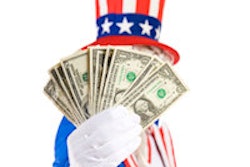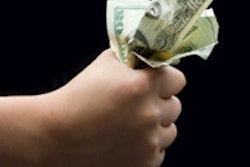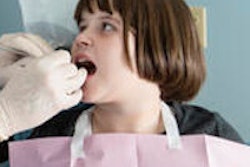
Average annual out-of-pocket payments for dental services in the U.S. rose 26% from $520 in 1996 to $653 in 2010, according to a new federal report, which found that more people, especially children, turned to federal programs for dental care.
The 82-page report, "Dental Services: Information on Coverage, Payments, and Fee Variation," was released by the U.S. Government Accountability Office (GAO) in September. The analysis was requested by Sen. Bernie Sanders (I-VT), who held a Senate subcommittee hearing last month regarding America's dental care crisis, primarily the obstacles to dental care that many children, poor adults, seniors, immigrants, and rural residents face. Sanders has submitted the Comprehensive Dental Reform Act of 2013, which aims to expand dental coverage, create new access points, enhance the workforce of dental professionals, improve education, and provide funding for new research.
Variation in fees
Perhaps the most revealing aspect of the report was the notable variation of fees for many common procedures, which cost twice as much in some communities compared with others.
For 24 common dental procedures, dental fees charged by local dentists varied significantly between the 18 communities examined in the report. In eight of the common procedures, upper-end fees were at least double the midpoint fees in several communities.
“The report allows the stakeholders in our nation's dental care system ... to begin a more informed dialogue.”
"There are many reasons for the wide variation of dental fees, and the report allows the stakeholders in our nation's dental care system -- from dentists to insurers to policymakers to consumers -- to begin a more informed dialogue about the variation," Robin Gelburd, president of Fair Health, told DrBicuspid.com. Fair Health is an independent, nonprofit corporation that compiles dental and medical claims data (nondiscounted fees charged by providers) from private insurers.
To determine the extent of fee variation between and within communities, the GAO's report analyzed dental claims data compiled by Fair Health, as of January 2013, and obtained dental fee schedules from selected federally funded health centers.
The Fair Health dental dataset contains more than 140 million claims, including geozip data (the first 3 digits of postal ZIP codes) and ADA billing codes. Additionally, the GAO analyzed variances by demographic group, including age group and income level.
The report describes several aspects of dental costs:
- Trends in coverage for and use of dental services
- Trends in payments by individuals and other payors for dental services
- The extent to which dental fees vary between and within various communities across the nation
The GAO examined U.S. Health and Human Services national health survey data and national dental expenditure estimates, dental insurance claims data, and health center dental fees in 18 selected communities (based on census region, population, and dental claims volume).
Midpoint dental fees in 18 communities for teeth cleaning (adult and child), 2012
Source: GAO analysis of Fair Health data; Map Resources (map).
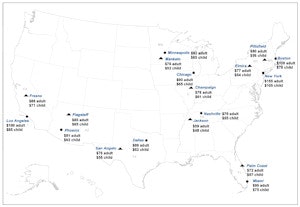
Click image to enlarge.
Source: GAO analysis of Fair Health data; Map Resources (map).
Background
According to national surveys, 42% of adults with oral problems did not see a dentist in 2008 because they did not have dental insurance or could not afford out-of-pocket payments. In 2011, 4 million children did not obtain needed dental care because their families could not afford it, the report noted.
In 2011, the Institute of Medicine reported that there is strong evidence that dental coverage is positively tied to access to and use of oral healthcare. National expenditures for U.S. dental services that year were about $108 billion, a significant increase from $64 billion in 1996, based on data from the U.S. Centers for Medicare and Medicaid Services (CMS).
In general, most health clinics in the GAO review charged no fees to the lowest-income patients for many, but not all, dental services.
Use of dental services
The percentage of people who had at least one dental visit during the year remained relatively unchanged, about 40% from 1996 to 2010, the report found. Specifically, some 43% of people in 1996 and 41% in 2010 had a dental visit.
Coverage
Overall, trends in dental coverage showed little change from 1996 to 2010 -- about 62% of people had coverage. But the number of people with private dental insurance dropped slightly, from 53% to 50%.
The report had some good news: Dental coverage for children through Medicaid or the State Children's Health Insurance Program (CHIP) rose from 9% to 13%, due to an increase in the number of children covered by these federal-state health programs. Also, the number of people with no dental coverage dropped from 28% to 25%.
However, Medicaid and CHIP beneficiaries, particularly children, increasingly used dental care (from 28% to 37%) and still visited the dentist less often than privately insured children (58% in 2010).
Cost
People with private insurance saw average payments increase 21% from $242 to $294. However, those without dental coverage paid almost a third more (32%) out-of-pocket for oral care, with average payments rising from $392 to $518.
The ability to check and compare prices for dental care is especially important for dental patients, Gelburd noted, because dental insurance may only cover about 50% of dental procedures, leaving them vulnerable to high out-of-pocket bills. Fair Health provides a free dental cost lookup service that consumers can use to research charges typical to specific geographic areas.
For example, in Miami, half of the fees charged by dentists for a periodic oral examination of an established patient were $62 or less, but 5% of dentists charged $150 or more for the same exam, a whopping 142% difference. In New York City, half of the dentists charged $290 for extractions, but higher-priced practitioners charged more than twice as much, $600. In Los Angeles, half of the dentists charged $40 for adult fluoride applications but some charged double, $80.
In small communities, the percentage difference was less, ranging from 17% to 58%.
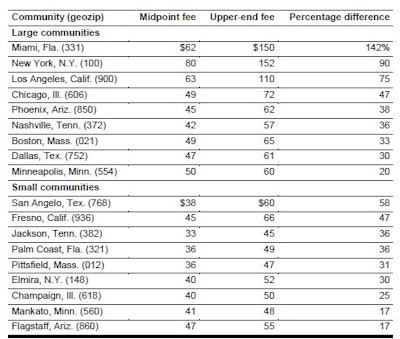 Source: GAO analysis of Fair Health data (as of January 2013). ADA Current Dental Terminology (CDT) definitions.
Source: GAO analysis of Fair Health data (as of January 2013). ADA Current Dental Terminology (CDT) definitions.For the most common restorative procedure, fillings, the percentage difference between midpoint and upper-end fees in large communities ranged from 19% to 67%, the report found. For example, in Phoenix, half of the fees charged by dentists for a filling were $195 or less, but 5% of dentists charged $325 or more for the same procedure, a 67% difference.
Dental fees also varied between local dentists billing private insurers and health centers serving residents of the same community.
For a comparison of adult prophylaxes in large communities, half the dentists in Nashville, TN, charged $76, while the midpoint cost was $155 by New York City dentists. In smaller communities, midpoint fees ranged from $59 in Jackson, TN, to $88 in Fresno, CA. Similarly, midpoint fees charged for a child prophylaxis ranged from $55 to $105 in large communities and $48 to $71 in small communities.
For more expensive procedures such as endodontics, half of Dallas dentists charged $1,025 for molar root canals, but some dentists charged 64% more ($1,677) for the same procedure.
For patients with incomes at or below 100% of the federal poverty line, 10 health centers charged nothing for extractions, while eight health centers had fees ranging from $16 to $148.
"Having information about typical charges in an area allows patients to begin a more constructive discussion with their dentist about the price of their care," Gelburd noted. "Such discussions help to ensure that patients are making truly informed choices about their care and will only serve to improve provider-patient relationships over the long term."




